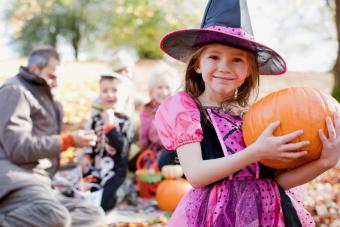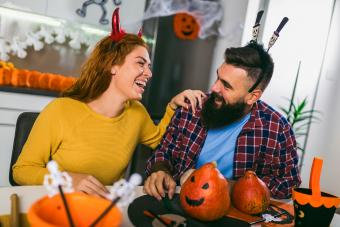
With its creepy costumes, festive decorations, and sweet candy, Halloween seems like a uniquely American tradition. But it isn’t. Immigrants brought Halloween to America and other places in the world. Today, Halloween is very popular in a few countries and is gaining popularity in others. And some nations celebrate Halloween alongside other traditional holidays.
What Countries Celebrate Halloween?
People in Ireland and Scotland observed Halloween for centuries. Irish and Scottish immigrants brought many Halloween customs to America in the 19th century. Because of American influence, by the late 20th and early 21st century, Halloween celebrations began to spread worldwide.
Many countries celebrate Halloween, sometimes called All Hallows' Eve, which occurs annually on October 31st. Some European and Latin American countries celebrate the official Catholic holidays, All Saints' Day on November 1st and All Souls' Day on November 2nd.
Halloween traditions are unique to each country. However, look for a totally American commercialized style of celebration with costumes and trick-or-treating, and you might have difficulty finding them.
Halloween in the USA
Halloween is very popular in the United States. In the USA, Halloween is celebrated with mischief and merriment. It's a day of spooky Halloween symbols such as owls, witches, black cats, and bats, along with fun activities like donning costumes, attending festive gatherings, carving jack-o'-lanterns, and trick-or-treating.
Halloween in Canada
Halloween is very popular in Canada and celebrated much like it is in the USA. It's a fun and festive night filled with costume parties and trick-or-treating. Canada's claim to Halloween fame is the phrase "trick or treat," which dates back to 1927. This was when an Alberta, Canada newspaper article reported that "pranksters were visiting houses demanding either a trick or treat."
Halloween in the UK
The Scots, Irish, English, and Welsh all celebrate Halloween alongside the Gaelic festival of Samhain. The Americanized version of Halloween was never big in the UK. In England, Guy Fawkes Day, on November 5th, has long been more exciting than Halloween. Still, you're likely to see pumpkins, costumes, and kids going door-to-door trick or treating in the UK.
Halloween in Mexico

Some people in Mexico do celebrate Halloween, and they also celebrate Day of the Dead (el Día de los Muertos), which is actually a two-day celebration that's held annually on November 1st (All Saints' Day) and 2nd (All Souls' Day.) Day of the Dead festivities have skeleton imagery, sugar skulls, and marigold flowers. During this time, families welcome back the souls of departed loved ones and celebrate their lives with food, music, costumes, and decorated gravestones. Private altars, called ofrendas, are built and used to present gifts to the dead. The Day of the Dead is also celebrated in various forms in many other Latin American countries, including Peru, Nicaragua, and Colombia.
Halloween in Spain
Halloween in Spain has a unique traditional feel which sets it apart from most European countries. Like Mexico and other Spanish-speaking nations, Spain celebrates El Dia de los Muertos (Day of the Dead or All Souls' Day). Halloween in Spain is a three-day celebration that begins on October 31st with Dia de las Brujas (Day of the Witches), continues with Dia de Todos los Santos (All Saints' Day) on November 1st, and finishes up with Dia de los Muertos (Day of the Dead) on November 2nd. During the Dia de Todos los Santos, a public holiday, families gather at the graves of their deceased loved ones with holy water, flowers, food, and drinks as they rejoice and socialize. Still, Halloween activities vary from city to city. For instance, in Galicia, Spain, there's a mixture of Celtic traditions and modern Halloween adaptations, along with the Catholic tradition of honoring dead loved ones by visiting their graves.
Halloween in Italy
Halloween is gaining popularity across Italy. However, La Festa di Ognissanti (All Saints' Day) on November 1st and Il Giorno dei Morti (All Souls' Day) on November 2nd are widely celebrated with an array of events and parties. On the island of Sardinia, people celebrate All Souls' Day by carving pumpkins called Concas de Mortu, meaning heads of the dead. The holiday begins on October 31st and goes through November 2nd to include All Souls' Day. Although there's not much trick-or-treating, and celebrations vary throughout the many regions, Italians celebrate loved ones who have passed on All Souls' Day.
Halloween in Poland
Although Polish businesses might decorate a store window for Halloween and there may be costume parties, many Polish people are very protective of their traditions. Therefore, the Americanized version of Halloween has not gained a foothold in Poland. The Polish celebrate Forefathers' Eve, an old Slavic custom that has been syncretized with the Christian celebrations of the All Souls' Day held on November 2nd. During Forefathers' Eve, there's a silent procession to ancestors' graves, where a grave candle is lit and placed on the graves of relatives and friends. On this night, extra places are also set at dinner tables, so the spirits of the dead can join in. After dinner, leftover food is taken to the cemetery.
Halloween in the Philippines
In the Philippines, Halloween incorporates All Saints' Day and All Souls' Day with Halloween. On October 31st, children participate in Pangangaluluwâ and go door-to-door singing songs in exchange for sweets. However, the country's traditional celebration takes place on November 1st and 2nd. These days are spent holding reunions at the cemetery, where tombs are cleaned and repaired and prayers are offered, followed by feasts and merriment.
Halloween in China
Halloween is a non-event for local Chinese people. It's doubtful you'll see any signs of Halloween outside of major cities. In cities with expatriate communities, you might see pumpkins and a few storefronts decorated for Halloween. Still, you won't find Chinese children knocking on doors for treats. Halloween is overshadowed by the Feast of Hungry Ghosts celebration that occurs during the fall harvest season. This is when the Chinese believe the gates of Hell open. And spirits of those who were ignored, murdered, or didn't have a proper burial are honored with food and fake paper money, which is burned as an offering to pacify these spirits.
Halloween in India
In India, Halloween celebrations may occur in large cities such as Delhi and Mumbai. During the day, you'll see people in large cities dressing like ghosts in scary makeup. Bars, clubs, and hotels also have scary-themed parties to attract customers. However, Halloween has also faced criticism in India. Many Indians disapprove of celebrating departed souls and saints by highlighting horror and ghosts.
Halloween in Australia
Halloween is catching on in Australia, where an orange balloon is hung outside the house to signal that there's candy for trick-or-treaters. Still, most Australians don't get excited because Halloween essentially marks the end of summer and harvest in the Northern hemisphere. In Australia, it's time for spring flowers. Still, Halloween is getting a foothold in Australia, especially among families with children. However, many people are still firmly opposed to it and consider it "an American thing."
Halloween in Japan

Halloween is growing in popularity in Japan. This began in 2000, when Tokyo Disneyland hosted its first Halloween event. Halloween is now a huge event, but there's no trick-or-treating. In Japan, Halloween is primarily enjoyed by adults who love creating and dressing up in costumes to attend such events as street parties and zombie runs.
The Around the World Rise of Halloween
Halloween has increased in popularity within the past 30 years. It's gaining traction in France, Greece, Poland, Sweden, Italy, and some Asian countries. But It's also encountered initial resistance from people who regard it as either an overly commercialized holiday or an American holiday that infringes on local customs and traditional holidays. However, in many countries, resistance has waned over time as new generations, often young urban dwellers, find ways to honor existing traditions and also incorporate modern-day Halloween.







